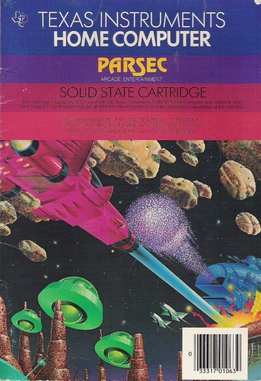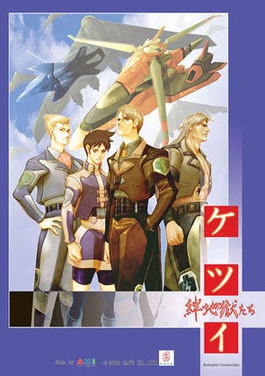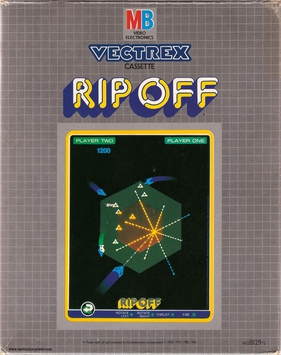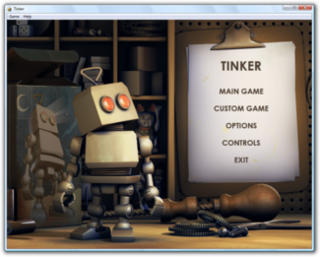
Super Scope 6, known as Nintendo Scope 6 in Europe and Australia, is a shooter video game developed by Nintendo and Intelligent Systems and published by Nintendo for the Super Nintendo Entertainment System. The game was bundled with the Super Scope for the Super NES. As the name suggests, the cartridge contains six games that require the Super Scope to play.

Tempest is a 1981 arcade game by Atari Inc., designed and programmed by Dave Theurer. It takes place on a three-dimensional surface divided into lanes, sometimes as a closed tube, and viewed from one end. The player controls a claw-shaped "blaster" that sits on the edge of the surface, snapping from segment to segment as a rotary knob is turned, and can fire blaster shots to destroy enemies and obstacles by pressing a button.

Tron is a coin-operated arcade video game manufactured and distributed by Bally Midway in 1982. The game consists of four subgames inspired by the events of the Walt Disney Productions motion picture Tron released earlier in the summer. The lead programmer was Bill Adams. The music programmer was Earl Vickers.

Gravitar is a color vector graphics multidirectional shooter arcade video game released by Atari, Inc. in 1982. Using the same "rotate-and-thrust" controls as Asteroids and Space Duel, the game was known for its high level of difficulty. It was the first of over twenty games Mike Hally designed and produced for Atari. The main programmer was Rich Adam and the cabinet art was designed by Brad Chaboya. Over 5,427 cabinets were produced. An Atari 2600 version by Dan Hitchens was published by Atari in 1983.

Turok 2: Seeds of Evil is a first-person shooter video game developed by Iguana Entertainment and published by Acclaim Entertainment. It was released for the Nintendo 64 console in 1998 and ported to Microsoft Windows computers in 1999. Seeds of Evil is the second game in the Turok video game series and a sequel to Turok: Dinosaur Hunter. The game follows the story of a Turok and his efforts to stop a powerful alien entity from escaping the confines of his Lightship. A different game set in the same fictional universe, also titled Turok 2: Seeds of Evil, was released for the Game Boy Color alongside the Nintendo 64 game.

Battle City is a multi-directional shooter video game for the Family Computer produced and published in 1985 by Namco. It is a successor to Namco's 1980 Tank Battalion, and would be succeeded itself by the 1991 Tank Force.

Combat Missions was a one-hour-long reality TV show produced by Mark Burnett and hosted by former Survivor castaway Rudy Boesch that aired from January to April in 2002 on the USA Network. It pits four teams of highly experienced military and police operatives against each other in physical challenges and "mission" scenarios. Each team has a call sign and corresponding color. The four teams are Alpha (Red), Bravo (Blue), Charlie (Yellow) and Delta (Green). The team members were past and present members of SWAT, the United States Army Special Forces, the Navy SEALs, Marine Recon, the CIA Special Operations Group, Delta Force, and the U.S. Army Rangers. The mission scenarios has each team face off against the opposing "Shadow force" using MILES gear in real-life combat situations. The show was not picked up for a second season.

Shamus is a shooter with light action-adventure game elements written by Cathryn Mataga and published by Synapse Software. The original Atari 8-bit family version was released on disk and tape in 1982. According to Synapse co-founder Ihor Wolosenko, Shamus made the company famous by giving it a reputation for quality. "Funeral March of a Marionette", the theme song from Alfred Hitchcock Presents, plays on the title screen.

Metal Slug is a Japanese multimedia franchise and run and gun video game series originally created by Nazca Corporation before merging with SNK in 1996 after the completion of the first game in the series. Spin-off games include a third-person shooter to commemorate the 10th anniversary of the series and a tower defense game for the mobile platform. Originally created for Neo-Geo arcade machines hardware (MVS) and the Neo-Geo home game consoles (AES) hardware, the original games have also been ported to other consoles and mobile platforms throughout the years, with several later games created for various other platforms. The games focus on the Peregrine Falcon Squad, a small group of soldiers who fight against a rebel army, aliens, zombies, mummies and various other forces intent on world domination.

Warp & Warp is a multidirectional shooter arcade video game developed and published by Namco in 1981. It was released by Rock-Ola in North America as Warp Warp. The game was ported to the Sord M5 and MSX. A sequel, Warpman, was released in 1985 for the Family Computer with additional enemy types, power-ups, and improved graphics and sound.

Cybertron Mission is a multidirectional shooter released by Micro Power in 1983 for the BBC Micro and Acorn Electron and ported to the Commodore 64 in the same year. The game is heavily influenced by the 1982 Atari 8-bit family game Shamus, which was itself inspired by the 1980 arcade game Berzerk.

Parsec is a horizontally scrolling shooter written by Jim Dramis and Paul Urbanus for the TI-99/4A and published by Texas Instruments in 1982. Dramis also programmed Car Wars and Munch Man for the TI-99/4A.

Ketsui: Kizuna Jigoku Tachi is a vertical shoot 'em up arcade game by Cave. It was released in Japanese arcades in 2003. A Nintendo DS boss rush version was released on October 23, 2008 in Japan. It included a Superplay DVD featuring a world record scoring run by a top ranked player. The arcade game was ported to the Xbox 360 and released in 2010. A special version of Dodonpachi Daifukkatsu Black Label was released on the Xbox 360 in 2011, which is a crossover with Ketsui, featuring the ship, re-arranged music and scoring system from Ketsui on top of the Dodonpachi Daifukkatsu Black Label scoring system.

Perfect Dark is a 2000 action game developed and published by Rare for the Game Boy Color. As a direct prequel to its Nintendo 64 counterpart, the game follows agent Joanna Dark as she completes her training at the Carrington Institute research centre and uncovers information against rival corporation dataDyne. The gameplay revolves around shooting opponents and completing objectives such as rescuing hostages or recovering items. The game also includes a multiplayer mode where two players may compete against each other in several deathmatch modes.

Iron Tank: The Invasion of Normandy, known as Great Tank in Japan, is a 1988 top-view action shooting game produced by SNK for the Nintendo Entertainment System.

Rip Off is a multidirectional shooter with black and white vector graphics written by Tim Skelly and released as an arcade video game by Cinematronics in 1980. It was the first shooter with cooperative gameplay and an early game to exhibit flocking behavior. A port for the Vectrex was published in 1982.

Tinker, also known as Microsoft Tinker, is a puzzle video game developed by Fuel Industries in which the player controls a robot through various mazes and obstacle courses. It was originally released on September 23, 2008 as part of Windows Ultimate Extras, and contained 60 levels including a 20-level tutorial. A free map editor was also released, however it is not compatible with the Games for Windows – Live version of Tinker. It is only compatible with the Windows Ultimate Extras version.

Space Invaders Extreme 2 is the sequel to Space Invaders Extreme. Space Invaders Extreme 2 features new content compared to its predecessor. A cut-down version of the game called Space Invaders Extreme Z has been made available on DSiWare for 500 Points.

Mercenaries is an action-adventure video game franchise published by LucasArts and developed by Pandemic Studios. It consists of two games: Mercenaries: Playground of Destruction and Mercenaries 2: World in Flames. Two further games — Mercs Inc and Mercenaries 3: No Limits — were cancelled during development.

Bolo is a video game written by Jim Lane for the Apple II and published by Synergistic Software in 1982. It was inspired by Keith Laumer's 1976 science fiction novel Bolo: Annals of the Dinochrome Brigade, which featured self-aware tanks.




















